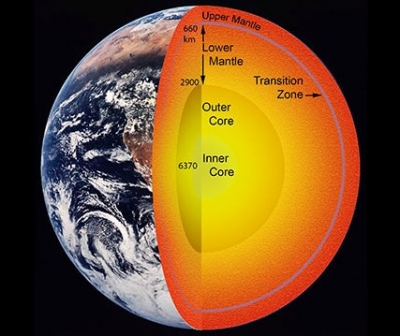
|
Scientists have worked this out from the vibrations from earthquakes and underground explosions. This data is pictured with lines on 3D maps to help scientists understand the structure of Earth’s core. |
Core, mantle, and crust are divisions based on composition. The crust makes up less than 1 percent of Earth by mass, consisting of oceanic crust and continental crust is often more felsic rock. The mantle is hot and represents about 68 percent of Earth’s mass. Finally, the core is mostly iron metal. The core makes up about 31% of the Earth.
CRUST AND LITHOSPHERE
Earth’s outer surface is its crust; a cold, thin, brittle outer shell made of rock. The crust is very thin, relative to the radius of the planet. There are two very different types of crust, each with its own distinctive physical and chemical properties.Oceanic crust is composed of magma that erupts on the seafloor to create basalt lava flows or cools deeper down to create the intrusive igneous rock gabbro. Sediments, primarily muds and the shells of tiny sea creatures, coat the seafloor. Sediment is thickest near the shore where it comes off the continents in rivers and on wind currents.
MANTLE
The two most important things about the mantle are: (1) it is made of solid rock, and (2) it is hot. Scientists know that the mantle is made of rock based on evidence from seismic waves, heat flow, and meteorites. The properties fit the ultramafic rock peridotite, which is made of the iron- and magnesium-rich silicate minerals. Peridotite is rarely found at Earth’s surface.Scientists know that the mantle is extremely hot because of the heat flowing outward from it and because of its physical properties. Heat flows in two different ways within the Earth: conduction and convection. Conduction is defined as the heat transfer that occurs through rapid collisions of atoms, which can only happen if the material is solid. Heat flows from warmer to cooler places until all are the same temperature. The mantle is hot mostly because of heat conducted from the core. Convection is the process of a material that can move and flow may develop convection currents.
CORE
At the planet’s center lies a dense metallic core. Scientists know that the core is metal for a few reasons. The density of Earth’s surface layers is much less than the overall density of the planet, as calculated from the planet’s rotation. If the surface layers are less dense than average, then the interior must be denser than average. Calculations indicate that the core is about 85 percent iron metal with nickel metal making up much of the remaining 15 percent. Also, metallic meteorites are thought to be representative of the core.If Earth’s core were not metal, the planet would not have a magnetic field. Metals such as iron are magnetic, but rock, which makes up the mantle and crust, is not. Scientists know that the outer core is liquid and the inner core is solid because S-waves stop at the inner core. The strong magnetic field is caused by convection in the liquid outer core. Convection currents in the outer core are due to heat from the even hotter inner core. The heat that keeps the outer core from solidifying is produced by the breakdown of radioactive elements in the inner core.
Credit: Lumen Learning
Picture credit: Google




